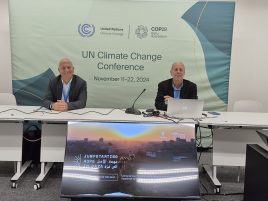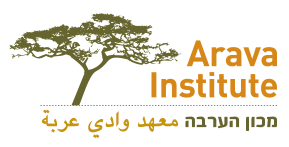
The COP has assigned theme days. Friday’s themes were ‘energy’ and ‘peace, relief and recovery’. These are considered two separate themes officially, which seems odd from the Arava Institute’s point of view. One of the questions I raised in my introductory blog was about being an environmental peacebuilding institute in a time of war. Friday’s themes spoke to that tension.
In the morning, I went to a fascinating session on “Renewable Energy as a Tool for Peace”, which was the only event all day connecting the two themes. Speakers discussed challenges in different regions of the world, and raised some interesting examples and ideas.
For example, the importance for global international organs and mechanisms to look at the fragility of communities, and not just national fragility, was discussed. Panelists emphasized that global finance needs to support more decentralized solutions. This resonates with the Institute’s work which is very community focused and based on decentralized solutions. De-risking mechanisms are needed in many conflict and post-conflict zones to enable private financing.
An organization called Energy Peace Partners presented their program for peace renewable energy credits established under the international reg standards and frameworks. They are using this as a mechanism for investments in Sub-Saharan Africa.
Mid-day, Dr. Tareq Abu Hamed and I participated in round tables on education as a tool for regional cooperation co-sponsored by the Israeli Ministry of Regional Cooperation and the Azerbaijani Ministry of Technology and Education.
Friday afternoon we hosted an invitation-only meeting on our Jumpstarting Hope in Gaza project led in cooperation with Damour for Community Development. Serious research, funding, potential organizational partners, and interested individuals came for an in-depth conversation about the coalition and initiative. After a presentation from Dr. David Lehrer, we were asked about risk elements in Gaza for investment, and the safety of the project and the displaced people living there. High level assistance requires deep coordination of the location of the refugee camps and interventions. Further, the project is designed to be highly mobile, if need be. This is important as well so that technologies and interventions can be moved to final home communities in the long-run when replaced.
One participant commented that based on their experience in the field, work on the local community-based level should also include social integration – many of the interventions in MENA do not include these elements. Social integration elements are often too hasty and awkward and not given enough attention. However, the community level tensions and challenges that arise without social integration can cause issues.
The conversation was productive and constructive, and some valuable new connections and possible partnerships were made.

